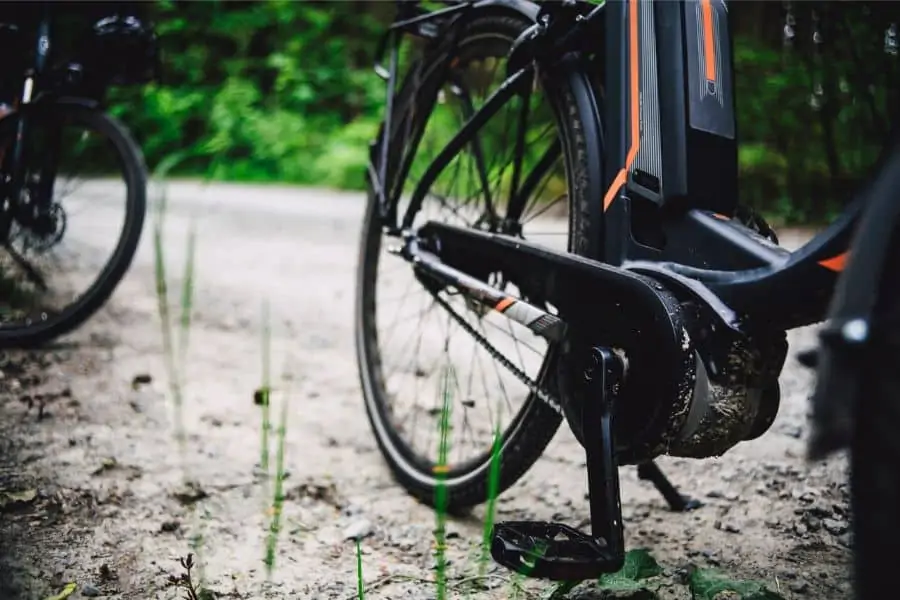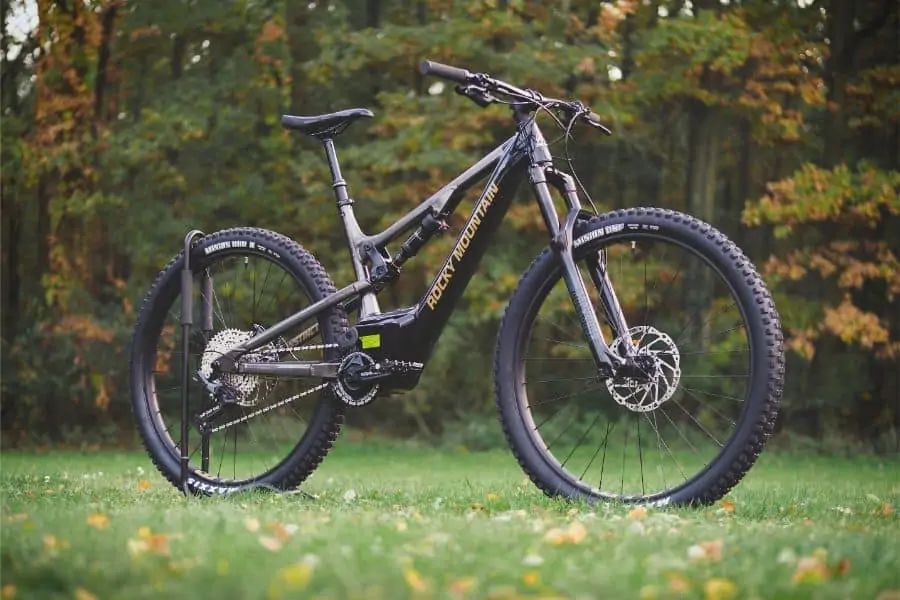
Choosing the correct type of e-bike can seem like a daunting decision, and knowing the correct type of e-bike motor to consider is part of that decision. I’ve done the research from my years of experience as an e-bike owner to make your decision easier. There are two main types of motors – hub motors and mid-drive motors. Hub motors are located inside the front wheel or the rear wheel, and mid-drive motors are located inside the frame of the e-bike close to the pedals.
- Cyclists who value a simpler, less-maintenance, more budget-priced bike, and don’t mind a prominent motor in the bike wheel- a hub-motor is ideal.
- Cyclists who often cycle hills, who value a lighter, stealthier motor built inside the bike frame, who value easier tire changes- a mid-drive motor is the better choice.
- Hub-motor advantages – there is little or no maintenance since the motor and all of its components are contained inside the wheel. Hub-motor e-bikes generally cost considerably less than mid-drive motor e-bikes
- Mid-drive motor advantages – the ability to change the gear as required by the terrain. This means that they are much more effective going up hills. Mid-drive motors are usually smaller and lighter than a hub motor and can be incorporated into the e-bike frame for a stealthy look. Changing tires is much easier as the motor doesn’t get in the way of removing the wheel.
Of course, these items are only some of the considerations that you should consider when making your choice for an e-bike purchase. Read on below for the full details of the pros and cons for both types of motors.

Table of Contents
Which Type of Cyclist is Suited to Each Type of E-Bike Motor?
| Hub-Motors Buyer | ★ More budget-conscious, e.g. student, or casual commuter ★ Wishes to minimise bike maintenance ★ Is not likely to encounter many steep hills, and normally cycles on flat terrain |
| Mid-Drive Motors Buyer | ★ Wants to have the maximum e-bike performance available ★ May wish to have a stealthier-looking e-bike – some models have the motor completely hidden ★ Wishes to have the maximum possible performance on hills, or as is a mountain biking enthusiast ★ Wishes to have fewer problems when changing tires ★ Wishes to have the maximum options available for wheel parts and tires |
E-Bike Motors Types – Rundown of all the Advantages and Disadvantages of Each Type of Motor

Let’s explore the main pros and cons of the two main types of e-bike motor types on the market. Hub-motors are a more established technology, but they do have their shortcomings which mid-drive motors aim to address.
| Advantages | Disadvantages | |
| Hub-Motors | ✔ Little or no maintenance ✔ Cheaper to purchase ✔ Fewer points of failure ✔ Doesn’t stress other components like the bike chain ✔ Works independently of the pedals- so you can pedal home without the motor if needed ✔ Long-established, proven design | ✖ Only a single gear ratio- not ideal for frequent hilly terrain ✖ Heavy ✖ Changing tires is more complicated ✖ Adds width to the wheel- so your choice of tires and other parts is more limited |
| Mid-drive motors | ✔ Adjustable gear ratio- so the correct torque for powering up a steep hill or from a complete stop is available from the motor ✔ Smaller and lighter ✔ Stealthier installation- blends into the frame. Some are completely hidden inside the frame ✔ Changing tires is much easier ✔ No restrictions in your choice of tires and other parts | ✖ More expensive to buy ✖ Adds considerable stress to other bike components, especially the chain ✖ Only possible to ride the bike downhill if the chain is broken ✖ More complexity, more moving parts ✖ Shifting gears isn’t possible while stopped |
Knowing the Differences Between Front and Rear Wheel Hub Motors
Hub-motors can be attached to either the front or back wheel of the bike. Nowadays, rear-wheel hub-motors are more common. Think of rear-wheel hub-motors as behaving similarly to rear-wheel-drive cars. Since the power is coming behind the rider from the rear wheel, it has a pushing effect or feeling as you ride the bike. Riding a bike with a front wheel hub motor has a pulling effect.
I myself ride a rear-wheel hub motor. These bikes are an ideal commuter e-bike and for more casual rising generally. This type of e-bike has the advantage of having better traction, due to more weight towards the rear of the bike and a stronger frame attachment compared to the front forks of the e-bike. If you are considering building your own DIY e-bike with a powerful hub motor, it’s best to attach it to the rear wheel for this reason.
Some of the downsides of the rear wheel hub-drive motor are that all the weight is towards the back of the bike and that removing the rear wheel is more complicated.
The unbalanced weight can be an issue when you are parking up the bike and you’re navigating the bike on foot in tight spaces. If you need to lift the bike up to move it, it can be somewhat tedious. It can be annoying also as there might be a tendency for the bike to tip over easily when carrying out maintenance or cleaning. This can be partially mitigated by having a sturdy bike stand that is adjusted well for your bike. Overall, it’s a minor inconvenience.
The issue of changing tires can make the thought of e-bike maintenance more daunting, particularly getting at the rear wheel inside the frame. It can be tricky to remove the rear wheel and the connected cables, washers and nuts and to then reattach everything afterwards in the correct order. My advice here is to consult the manual and ideally some Youtube videos on the topic, so you can understand the task. Proceed slowly, put all the washers and nuts that you remove into a small container, and take frequent photos with your smartphone of each part as you remove it. That way, you will not forget which order each item should be reattached afterwards. If you frequently cycle in an area with lots of broken glass, you should strongly consider purchasing special puncture-resistant tires. They cost a little more, but you will feel extra clever the next time you cycle over broken glass and hear the dreaded crunch!
Mid-Drive Motor Features
Mid-drive motors are a new type of e-bike motor that has become much more popular in the last number of years. They were designed to address a number of shortcomings of more traditional hub-motors. There are multiple large companies that have entered this market in recent times, such as the German industrial giant Bosch, the bike parts marker Shimano, the Japanese conglomerate Yamaha, and Chinese companies, notably Bafang. If you want the latest and greatest performance, then a mid-drive is the obvious choice.
Most mid-drives do not offer a separate throttle. You must pedal bike to actually activate motor assist, so it’s offers and natural riding experience with less effort than a normal bike ride. This allows you to travel further, with more speed, to get where you’re going much faster. It can also conquer hills with ease due to the adjustable gears in the motor – the main advantage over a hub-drive motor. There are some high-powered e-bikes, known as S-Pedelecs, that offer throttle assist and speed boosts up to much higher speeds.
Mid-drives also have a superior balance compared to hub-drive motors. The heavy e-bike components are located towards the middle of the bike – in other words, the motor and battery. This can make for a more pleasant riding experience.
Mid-Drives on Hills
Mid-drives shine brightest when clambering uphill or shooting up a mountainside with ease. If you are considering an e-Mountain Bike purchase (abbreviated to e-MTB) then a mid-drive is the only option.
Stealthy E-Bikes
If you like the idea of having an e-bike, but don’t like the look of a bulky motor inside the wheel, then a stealthy mid-drive e-bike is the option to consider. This stealth-look trend has become popular in recent years, with increasing numbers of e-bike manufacturers selling models that have the motor and sometimes even the battery cleverly hidden inside the e-bike frame.
Mid-Drive Downsides
One downside of mid-drives is that because the motor is inside the bike frame, the entire bike must be specifically designed around the motor. This drives up the purchase cost since the bike must be specially designed for this purpose. In the case of hub-motors, these can be added to an existing bike design from the manufacturer since the motor is entirely inside one of the wheels. This downside of mid-drives is less of an issue nowadays since they are quite well established, but it is worth bearing in mind if you are wondering about the price difference.
Another downside of mid-drives is the additional stress exerted on the chain. The extra torque from the motor is applied directly to the chain, and if the chain isn’t strong enough, can cause it to break. The best way to mitigate this is to buy from a reputable e-bike brand, so you can have confidence that a quality chain has been selected to handle the extra stress. This is mostly a problem when riding up steep slopes, and is becoming less of an issue over time as bike makers are aware of the problem.
So there you have it! A comprehensive look at the two main types of e-bike motors in the market. There is an e-bike out there for everyone, and one of these types is sure to fit your needs!
Happy cycling!
